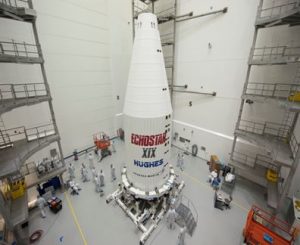Internet Provider HughesNet Finishes Testing Its Next-Generation Satellite

The fifth generation of satellite internet will, according to HughesNet, provide much faster data throughputs and a 50% greater capacity.

In December 2016, the internet provider successfully launched its EchoStar XIX satellite into geostationary orbit 22,236 miles above Earth. This February, HughesNet announced that it had completed a successful round of in-orbit tests on the four-ton EchoStar 19 and that the satellite was ready for use.
The EchoStar XIX, built by the satellite and spacecraft manufacturer Space Systems Loral, is a Ka-band high-throughput satellite. It features what HughesNet calls “the world’s most advanced”very small aperture terminal (VSAT) platform. The award-winning data-processing platform, developed by HughesNet, gives customers the highest possible capacity and efficiency of today’s satellite internet options. HughesNet calls the new internet service “Gen5.”
Like the EchoStar XVII before it, the EchoStar XIXwill use 138 beams to provide service to the continental United States, Alaska, Mexico, and parts of Canada and Central America.

With HughesNet Gen4 service, these areascurrently see download speeds of up to 15 Mbps and upload speeds of up to 1 Mbps. Gen5 will increase these numbers, although HughesNet can’t say by how much just yet.
Although it will likely be faster, HughesNet’s Gen5 service will not overcome satellite internet’s biggest stumbling block: high latency or lag time. Geostationary satellites orbit the earth at 22,236 miles above sea level, meaning that online data has to travel at least 44,472 miles round trip. This distance has long been a stumbling block for satellite internet, since it takes upwards of 700 milliseconds (ms) for a satellite signal to travel between earth and space.
A HughesNet™ competitor, Tesla Motor’s SpaceX, has begun a project that, if successful, could overcome satellite’s stumbling block.
Instead of sending satellites into high, stationary orbit like other providers, SpaceX unveiled plans last year to build a constellation of coordinated, moving satellites would orbit at 715 to 823 miles above earth.
Bringing satellites closer to earth solves the most pertinent problem with satellite internet – high latency. The company estimates that it will reduce the latency of satellite internet to 25 to 35 ms. Today’s satellite internet has a latency that is 7 to 25 times higher than mobile broadband and 50 to 150 times higher than cable. If successful, SpaceX’s satellite constellation will have a latency just 2 times higher than cable.
Rural Americans will be the first to benefit from SpaceX’s new project when it comes to fruition. Musk has appealed to the Federal Communications Commission (FCC) – the government agency that, along with the Department of Agriculture (USDA), has invested over $260 billion in mobile broadband expansion in the last seven years – to oversee the launch of 800 preliminary satellites.

SpaceX’s satellite constellation has the potential to make today’s geostationary satellite internet technology obsolete. Even if it doesn’t, it will likely increase the competition between providers. More competition could lower prices and encourage other providers to innovate.
Thanks to HughesNet and SpaceX, exciting things are happening in an industry that is, typically, immune from the fast-paced innovation of other technologies. Stay tuned for more information about Gen5 and satellite innovation this year.
If you need another reason to get pumped about HughesNet’s Gen5, be sure to watch the launch of the United Launch Alliance Atlas 5 – the vehicle that carried EchoStar XIX into space – from the Kennedy Space Center at Cape Canaveral, Florida, on Dec. 18, 2016.





